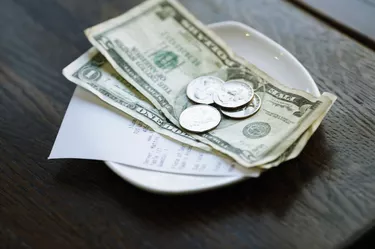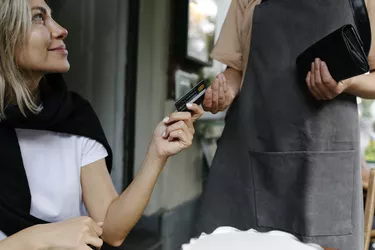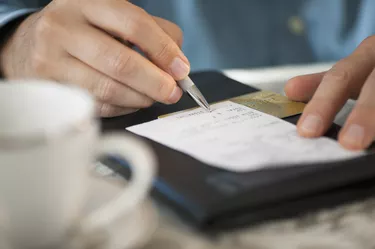It might be hard to figure out how to pay for dinner with your credit card if you just got your first one. You might worry about the safety of your card while it’s being charged, how to figure out a tip, or when the charge will show up on your bill. Luckily, restaurants are some of the most common places credit cards are used, and its become an incredibly smooth process.
Credit card payments for meals at restaurants are now something that a lot of people do. But if you’ve never used a credit card before, the process might be hard to understand at first. Don’t worry, though. It’s really easy to pay your restaurant bill with a credit card once you know how it works.
In this detailed guide, I’ll show you step-by-step how to pay your restaurant bill with a credit card and tell you what to expect and what to do. You’ll feel totally sure of yourself by the end and be ready to pay for your next restaurant meal like a pro!
Overview of Paying With a Credit Card at a Restaurant
Here are some general things you can expect when you use a credit card to pay for your meal at a restaurant:
-
The server checks the check, puts it in a folder, and leaves it at your table.
-
Review the bill carefully to ensure there are no errors.
-
Calculate the tip amount you wish to leave based on the service
-
Let the server know if you need change from cash for the tip.
-
Hand the check presenter to the server or take it up to the register.
-
The staff will take your card and process the payment.
-
You’ll receive back a printed receipt showing the itemized charges.
-
On the receipt, add your tip, total it up, and sign your name.
-
Keep the customer copy of the receipt for your records.
Now let’s look at each of these steps in more detail.
Receiving The Bill
In most restaurants, after you finish your meal, your waiter or waitress will bring the bill to your table in a folder, usually referred to as the check presenter. They’ll place it on the table discreetly and leave it for you to review.
This is the time to take a careful look at the bill to verify that all the charges listed match what you and your party actually ordered. Check for any extra drinks, appetizers, or other items you don’t remember ordering and make sure the quantities are correct. Also check for any duplicate charges.
If you notice any discrepancies, let your server know right away so they can be corrected before you pay the bill. It’s much easier to get mistakes fixed on the spot rather than trying to deal with an inaccurate charge later on.
Calculating The Tip
Once you confirm that all the charges on the bill are accurate, it’s time to calculate your tip. Tipping is standard practice at restaurants in the United States, with tips representing 15-20% of the total pre-tax bill amount.
While not legally required, tipping makes up the majority of a server’s income, so it’s expected that you leave a reasonable tip based on the service you received. Here are a couple easy ways to calculate 15-20%:
-
Move the decimal point one place to the left on the total bill amount. This gives you 10% of the bill, so just double it to get 20%.
-
Divide the total bill amount by 5 for 20% or 6 for 15% and round up to the nearest dollar.
-
Use the tip calculator on your phone’s calculator app.
For exceptional service, you may tip even higher than 20%. For unsatisfactory service, you can reduce the tip accordingly. Ultimately, the tip amount you leave is your decision.
Getting Cash For The Tip
If you want to leave some or all of the tip in cash, inform your server before they take your card for payment. Ask them to bring back some change from your card payment so you can leave cash on the table.
Specify the denomination you need – for example “Can I get $20 back in change please?” They’ll deduct that amount from your card total and bring it back to you in bills.
This allows you to pay the meal itself with your card but leave a cash tip. Make sure to put the cash tip on the table before you leave.
Paying The Bill
Once you’re ready to settle the bill, what happens next can vary a bit depending on the restaurant. At some more casual places, you’ll take the check presenter up to the register or counter yourself when you’re ready to pay. The staff will then process your card and payment right there.
At fancier or full-service restaurants, your server will often come to your table when you signal that you’re ready. You’ll hand them the bill folder with your credit card inside and they’ll take it away to process your payment.
Either way, your card gets swiped or inserted into a card reader by the staff. Make sure your card goes directly to an employee – never leave it unattended on an empty table.
Getting Your Card Processed
The restaurant staff member will insert your card into their point-of-sale device or card reader. They may ask to see your ID to verify your identity. The card reader communicates with your card network to authorize the transaction amount.
This is a very quick electronic process – your actual credit card will be returned to you within just a minute or two. The authorization “holds” the funds until the charge settles when the restaurant batch-closes out at the end of the day.
Receiving The Itemized Receipt
After your card is processed, the staff member will return your card along with a printed receipt itemizing your charges. It will show the restaurant name, date, time, payment method, and an itemized list of everything you purchased including food, drinks, appetizers, etc.
Check that all the items match what you ordered and that the subtotal amount is correct before tip. The receipt will also show the tax amount and total amount due.
Adding Tip & Signing The Receipt
There will be a blank line on the receipt for you to write in the tip amount you wish to leave. Add the tip to the subtotal listed. Then write in the new total at the bottom and sign your name on the signature line.
Signing authorizes the final charge amount including tip. Make sure your signature matches the one on your card.
The restaurant will provide you with two identical receipts – one marked “merchant copy”, one marked “customer copy”. Keep the customer copy for your records as proof of the transaction.
Tracking The Charge
It usually takes 1-3 days for restaurant charges to show up on your online credit card statement. The charge will appear as “pending” until it fully processes. Make sure the final charge amount exactly matches your receipt.
Download your card issuer’s app to monitor charges and receive instant notifications anytime your card is used. This allows you to quickly identify any fraudulent or inaccurate charges.
Why Use Credit Cards To Pay At Restaurants?
Paying with a credit card at a restaurant provides many benefits:
-
No need to carry cash or calculate exact change.
-
Earn rewards points and cash back on your purchases.
-
Provides a record of your purchases and expenses.
-
Offers fraud protection if your card number is stolen.
-
Allows you to delay payment until your credit card billing cycle.
-
Can dispute inaccurate or fraudulent charges.
So don’t hesitate to use your credit card to pay the bill next time you go out to eat! Following this guide, you can feel confident knowing exactly how to smoothly pay your restaurant bill with a credit card.

Paying Your Restaurant Bill
Video of the Day
Paying a restaurant bill with a credit card is very straightforward. First, your server will leave the bill with you on the table. Look the bill over and make sure the charges are accurate. Depending on the restaurant, you may hand the bill to the waiter, or you might take it up to a cash register to pay in person.



Video of the Day
Your server will be able to tell you how this works. Either way, the person responsible will take your credit card, ring up your charges and present you with a printed receipt.
Filling Out Your Receipt
When you buy something, the receipt shows the date and time, as well as the method of payment you used. The receipt will also show you the amount youre being charged for the meal, as well as its taxes. In most restaurants, therell be a line for a tip or gratuity. If youre charging a tip on the card, youll need to write the tips value into that line, then add it to the cost of the meal to get the final total to be charged to the card and sign underneath. This is what gives the restaurant permission to charge the meal to your card.



The restaurant will likely provide two copies of the receipt. One will denote itself as the customer copy at the top or bottom – this is a copy for your records. You can remind yourself what you tipped and what the total charge is if you choose to check the charge on your bill to make sure it matches. The restaurant will keep the other copy of the receipt for its records.
How to Pay at a Restaurant with a Card
FAQ
Can I pay a restaurant bill with a credit card?
Paying for anything with a Credit Card, online or offline, is simple. How to pay with a Credit Card at an offline store? To pay for your purchases at a retail outlet, be it a restaurant, a supermarket or a shopping mall, just present your card at the billing counter.
How does paying with a credit card work at a restaurant?
Typically, a server will drop the bill off at a table, then leave. Customers put their credit or debit cards on the table. When the server comes back, she takes the cards from the table and puts them on a fixed POS terminal so that the transaction can be completed.
How to pay with card at sit down restaurant?
Your server drops the check at the table, and you leave your card. Your server will come by and take your card. Payment will then be processed at the main point of sale (POS). This may take a few minutes or several minutes, depending on how busy the restaurant is and how many tables the server is responsible for. The server comes back with your receipt and walks away.
Is there a way to pay a bill with a credit card?
Services, utilities, and taxes can often be paid with a credit card but with a processing fee. Loan payments are usually check or bank withdrawal payments only.
Are credit cards a good way to pay restaurant bills?
When it comes to dining out, credit cards have become a popular form of payment. With their convenience and security features, credit cards offer a hassle-free way to settle restaurant bills. However, if you’re new to using credit cards at restaurants, you may have some questions about the process.
How do you pay a restaurant bill?
There are two ways to pay at some restaurants: you can hand the bill to the waiter or take it to the cashier. Your server will be able to tell you how this works. Either way, the person responsible will take your credit card, ring up your charges and present you with a printed receipt.
How does a restaurant pay a credit card?
The credit card issuer pays the restaurant on your behalf, and you repay the issuer at a later date, either in full or through monthly installments. It’s important to note that credit card payments can incur interest charges if you carry a balance from month to month.
How do I use my credit card at a restaurant?
If the restaurant uses portable payment devices or electronic tablets for payment processing, you may be able to swipe or insert your credit card directly into the device. Follow the instructions provided by the server or on the payment device itself to complete the transaction securely.
Should you pay your bill at the end of a restaurant meal?
For most diners, paying one’s bill at the finish of a restaurant meal is a simple, uncomplicated process, a no-brainer. Or should be. It never fails to amaze me how many people screw this up. The ideal execution of bill getting-and-paying should be a near-non-event.
Can you tip a restaurant with a credit card?
Tipping with a credit card in a restaurant usually follows a simple process: Ask for the bill. Look over your final bill and confirm it reflects what you ordered. Look to the pre-tax amount of your bill for tipping guidance. For a restaurant meal, the generally recognized amount to tip is 15% to 20% of the pre-tax bill in the United States.